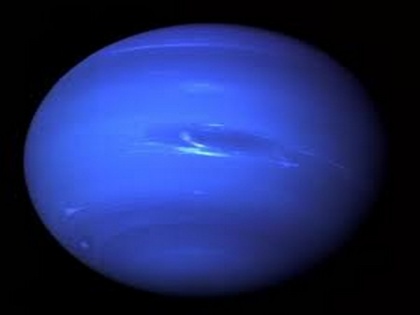Could mini-Neptunes be irradiated ocean planets?
By ANI | Updated: July 20, 2020 21:35 IST2020-07-20T21:21:37+5:302020-07-20T21:35:34+5:30
Many exoplanets known today are 'super-Earths,' with a radius 1.3 times that of Earth, and 'mini-Neptunes,' with 2.4 Earth radii. Mini-Neptunes, which are less dense, was long thought to be gas planets, made up of hydrogen and helium.

Could mini-Neptunes be irradiated ocean planets?
Many exoplanets known today are 'super-Earths,' with a radius 1.3 times that of Earth, and 'mini-Neptunes,' with 2.4 Earth radii. Mini-Neptunes, which are less dense, was long thought to be gas planets, made up of hydrogen and helium.
Now, scientists at the Laboratoire d'Astrophysique de Marseille (CNRS/Aix-Marseille Universite/CNES) [1] have examined a new possibility, namely that the low density of mini-Neptunes could be explained simply by the presence of a thick layer of water that experiences an intense greenhouse effect caused by the irradiation from their host star.
These findings, recently published in The Astrophysical Journal Letters, show that mini-Neptunes could be super-Earths with a rocky core surrounded by water in a supercritical state [2], suggesting that these two types of an exoplanet may form in the same way.
Another paper recently published in Astronomy & Astrophysics, involving in France scientists mainly from the CNRS and the University of Bordeaux [3], focused on the effect of stellar irradiation on the radius of Earth-sized planets containing water. Their work shows that the size of the atmospheres of such planets increases considerably when subject to a strong greenhouse effect, in line with the study on mini-Neptunes.
Future observations should make it possible to test these novel hypotheses put forward by French scientists, who are making major contributions to our knowledge of exoplanets.
Notes:[1] In collaboration with a researcher at the Laboratoire Atmospheres et Observations Spatiales (CNRS/UVSQ/Sorbonne Universite).
[2] Supercritical water exists at very high pressures and temperatures.
[3] The French scientists work at the Laboratoire d'Astrophysique de Bordeaux (CNRS/Universite de Bordeaux) and used a planetary atmosphere model developed at the Laboratoire de Meteorologie Dynamique (CNRS/ENS Paris/Ecole Polytechnique-Institut Polytechnique de Paris/Sorbonne Universite).
( With inputs from ANI )
Open in app